Table of Contents
12th gen Intel Alder Lake desktop hardware was launched in 2021, and then quickly followed by the 12th-gen laptop and ultrabook mobile platform as well.
The Alder Lake mobile platform was officially unveiled at CES 2022, and in the meantime, we’ve reviewed various designs and products, so we know what to generally expect from Alder Lake laptop chips.
I’m going to take you through what we know so far, and add in my own thoughts, to help you decide whether you should get an Alder Lake laptop at this point, or rather wait for the next-iteration of Intel 13th-gen Rocket Lake products to be available in stores somewhere next year.
Intel 12th-gen Alder Lake platform
Unlike with Tiger Lake and previous mobile platforms, Alder Lake is Intel’s first take of a Big.Little platform, an approach common in recent years for smartphones and tablets, as well as something implemented on recent Apple products built on Apple M1/M2 silicon.
In simple words, Big.Little means that bigger and higher performance cores are paired with smaller and more efficient cores in a single processor. The Big cores are meant to fire when demanding loads require increased processing power, and rest dormant otherwise. At the same time, the Little cores are active all the time and either in charge of efficiently running everyday demands, or helping out the Big cores with the taxing chores, based on the requirement.
In theory, this approach would primarily address efficiency, one of the known issues of the recent Intel platforms in comparison to the AMD Ryzen options, while also helping out the overall performance is sustained loads.
IPC per-core performance was never a problem for the 11th gen Tiger Lake chips over Ryzen 5000 platforms, but because of the increased power demands, Intel were only able to squeeze in fewer cores than AMD could within a given power envelope on their processors, and thus Tiger Lake Core U CPUs only topped at 4C/8T SKUs, and were trumped as a result in multi-thread performance by the up to 8C/16T AMD SKUs.
With Alder Lake, Intel still went with a limited number of Big Cores, but supplemented them with clusters of Small cores on each SKU.
Intel haven’t officially revealed their roster of mobile Alder Lake CPUs at this time, but we do know there’s an entire stack in preparation:
- low-power AlderLake-M 5-9W options meant for ultra-thin devices and tablets;
- mid-power AlderLake-P 15-28W options meant for ultrabooks and portable compact laptops;
- mainstream AlderLake-P 35-45W options meant for performance ultraportables and generally consumer laptops;
- enthusiast AlderLake-S 55+W meant for high-performance notebooks.
Here’s a more detailed look at the leaked roadmap:
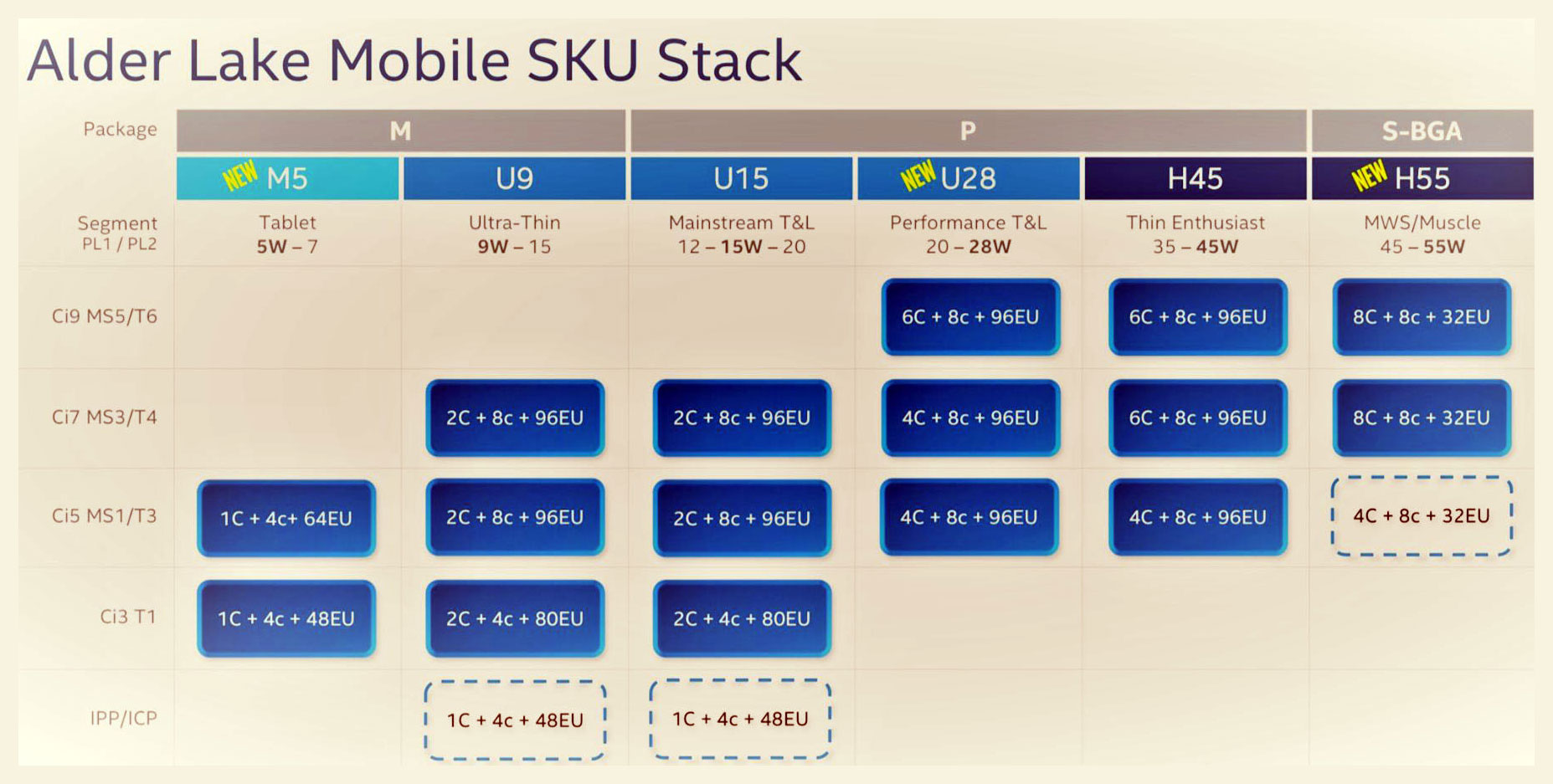
Source: Videocardz.com
Down below I also put up a short summary of the mainstream Alder Lake-P H45 options based on what we know so far from various sources. Take them with a lump of salt, as some of the info is based on rumors and leaks. The Big cores are marked as P (Performance) and the Little cores are marked as E (Efficiency).
| Core i9-12900HK | Core i9-12900H | Core i7-12800H, Core i7-12700H |
Core i5-12500H | |
| Lithography | Intel 7 – 10 nm | |||
| Design TDP | 35-45W | |||
| Cores (P+E)/Threads | 6+8/20 | 6+8/20 | 6+8/20 | 4+8/18 |
| P-Cores Base – Turbo | 2.9 – 4.9 GHz | 2.9 – 4.9 GHz | 2.7 – 4.6 GHz | 2.5 – 4.5 GHz |
| E-Cores Base – Turbo | 2.4 – 3.7 GHz | 2.4 – 3.7 GHz | 2.4 – 3.7 GHz | 2.4 – 3.7 GHz |
| Graphics | 96 EUs | 96 EUs | 96 EUs | 96 EUs |
| Cache | up to 24 MB Smart cache | |||
| Memory support |
DDR4-3200, DDR5-4800, LPDDR5-5200 | |||
As far as the Core U class of Alder Lake processors go, expect multiple options in the U28 subfamily meant for performance ultrabooks ranging between a Core i5-1240P (4C + 8c, 12 MB cache) and up to a Core i7-1280P (6C+8c, 24 MB cache). Also expect a multitude of CPU options in the U15 lineup of mainstream chips, ranging between 2C+4c and 2C+8c (i7-1255U) designs, as showcased in the roadmap mentioned earlier.
Let’s quickly dive into the P and E Cores that form this hybrid design.
The P-Performance cores are based on Intel’s Golden Cove architecture, a follow-up of the Willow Cove cores in the Tiger Lake processors. This is the first significantly-improved Intel microarchitecture in quite a few years, as very well explained in this article at Anandtech, and results in a combined 19% IPC increase over Cypress Cove as per Intel’s claims (not compared to Willow Cove -Tiger Lake, though), based on measurements in several workloads and benchmarks such as SPECviewperf, PCMark, WebXPRT or Geekbench.
The E-Efficiency cores are based on the Intel Gracemont architecture, a follow-up of Tremont and Goldmont that were at the basis of Intel Atom processors of the past. They’re quite an upgrade in performance over previous Atoms, though, as shown in this video. What’s important here is the performance per surface, as a cluster of 4 E-Cores is about 90% of the size of a P-Core, but offers roughly 120-130% of the performance of a P-Core in sustained loads, as per the mentioned video.
As a result, in an overly simplified explanation, with Alder Lake processors Intel replaced 2 Big P cores with two clusters of Little E cores compared to the TigerLake SKUs. That means the i7-12700H is now a 6Pc + 8Ec processor, with a total of 20 threads, compared to the i7-11800H which was an 8C/16T processor.
The E cores allow for efficient and low-temperature use on battery, with the laptops unplugged, but also make up for more than the performance of a replaced P core in demanding loads. Hence, paired with the improvements in IPC and various other design updates, Alder Lake processors should provide a significant increase in high single/multi-core performance over the Tiger Lake chips, alongside the more obvious improvements in energy drain with everyday chores.
And here we get to touch a little bit on the expected performance, based on a few rumors and what we already know from the PC Alder Lake parts, which are already available and have been reviewed by multiple trusted sources. But first, a few more details and the Alder Lake-P mobile hardware:
- memory support has been improved, with either DDR4-3200 on one hand, or DDR5 and LPDDR5 support as a novelty;
- Iris Xe graphics with up to 96 EUs (GT2 generation) are available with the Alder Lake-P chips at most power levels, with GT3 Iris only on the H55 Muscle chips;
- Thunderbolt 4, PCI Express 5.0, and Wi-Fi 6E are available with all SKUs.
Performance with daily use and demanding loads
With the increase in IPC and extra processing power, we can generally expect Alder Lale laptops to feel very snappy with everyday use and multitasking, while also running significantly more efficiently. However, I doubt you’ll be able to notice a performance difference with general use over the previous 2019-2020 hardware generations, though.
Update: In the meantime, we’ve reviewed multiple Intel 12th gen laptops here on the site, and we’ve also compared the mainstream Core i7-12700H Intel processor to the rival AMD Ryzen 7 6800H platform in this dedicated article.
The efficiency part should translate in significantly longer runtimes on battery, though, as well as cooler/quieter runs while plugged in, so hopefully, silent passive cooling with daily use would become the norm on more and more 2022 laptops.
However, all these will depend on the software’s ability to schedule and optimize workflows between the P and E cores, and that’s probably easier said than done. Alder Lake laptops will ship with Windows 11, and we’ll just have to wait and see how the scheduler does. I’d expect a bumpy road at first, and perhaps smoother later on with software patches. Look for our reviews for updates.
With demanding loads, early rumors suggest a significant performance boost in CPU multi-threaded tests, but I would take the early Geekbench leaks with reserved enthusiasm. We’ve seen an i9-12900HK leak scoring 1851 – Single Core and 13256 – Multi Core in a potential MSI GE76 Raider update. In comparison, the current i9-11980HK GE76 Raider scores up to 1650 – SC and 10000 – MC (source), so we could be looking at 15% higher single-core and 30% higher multi-core results. That would be impressive indeed, but I’m skeptical about that MC score. For what is worth, the previous i9-10980HK only scored 1250-SC and 7500-MC in the same Geekbench test in our review, so Alder Lake looks like a major update over the Comet Lake-H hardware generation from 2020.
There are also some Geekbench leaks for an i7-12700H in a few products (source), with SC scores between 1350 to 1680 points and MC scores of around 10500 to 11000 points. In comparison, the i7-11800H scores around 1500-1550 points in SC and around 8500-9500 in MC. These suggest a more realistic difference of 10-15% between the Alder Lake and the Tiger Lake mainstream Core i7 SKUs.
Of course, we could look for more answers into the already available reviews of the desktop K chips, but keep in mind that Alder Lake K hardware runs at much higher power in sustained loads, and the K chips also offer extra P Cores over the mobile H parts. Thus, expect lower performance on the H SKUs, as well a wide variation between the different implementations, based on the allowed power settings. That GE76 Raider mentioned above is a full-size laptop with one of the most permissive power settings you will find in a notebook (at 100+ W sustained), so even if we’re to believe those numbers, they would be best-case expectations for the i9-12900HK.
Look forward to our updates and reviews for more performance details.
12th gen Alder Lake Gaming performance
With notebooks rarely being CPU bottlenecked in games, unless you’re playing fast-paced titles at very low graphics settings in order to get 300+ framerates (such as CS:GO, Fornite, etc), I’d expect the impact of Alder Lake hardware in games to be even smaller than in sustained workloads and CPU benchmarks.
However, the combination of potentially higher sustained clocks and the extra bandwidth provided by the transition to DDR5 memory might benefit some games in a measurable and noticeable way. Our reviews will go over gaming tests in detail, and for now, I’ll just leave you with the video down below that goes over the gaming performance of the main-stream Core i5-12600K desktop chip. These results are especially interesting because the desktop i5 is a 6Pc+8Ec architecture, similar to what we’ll get with the mobile Core i7 and i9 options.
Conclusions
From what we know so far, I expect Intel Alder Lake hardware to be a competitive option in 2022, and possibly a first pick over the AMD options in certain scenarios. Tiger Lake had an edge over the AMD Ryzen 5000 Cezanne platforms in IPC and gaming, and was able to trade-blows in multi-threaded performance, but with higher power demands and lower efficiency.
With Alder Lake, the IPC difference increases, and the efficiency in daily chores should improve, but I’m not sure what to expect in terms of power draw and efficiency with demanding loads, and there’s also the question of how the software will be able to keep up with the hardware design.
Of course, AMD Ryzen 6000 Rembrandt is also coming on mobile computers next year, and that’s what Intel will have to take on with their Alder Lake hardware. However, given how Ryzen 6000 is a Zen3+ architecture, thus a refinement of their previous Zen3 Ryzen 5000, I’d expect Intel to have a slight edge, especially in the higher-performance products with dGPUs, where the integrated graphics won’t matter much. We’ll see.
AMD Zen4 is also coming later in 2022, but so does the Intel 13th gen Raptor Lake. However, for most of 2022, your mobile CPU choices will go between Intel Tiger Lake and AMD Rembrandt platforms. Look for our updates and reviews for more details.
Finally, check out the following articles for a deeper research on available 2022-generation laptops built on the latest mobile platforms: our guide on the best portable gaming laptops, our list of Intel Core i9-12900HK/H laptops, and our list of AMD Ryzen 9 6900HX options. This article also offers an in-depth analysis of the Intel i9-12900H and the AMD R9 6900HS platforms, in similar designs.


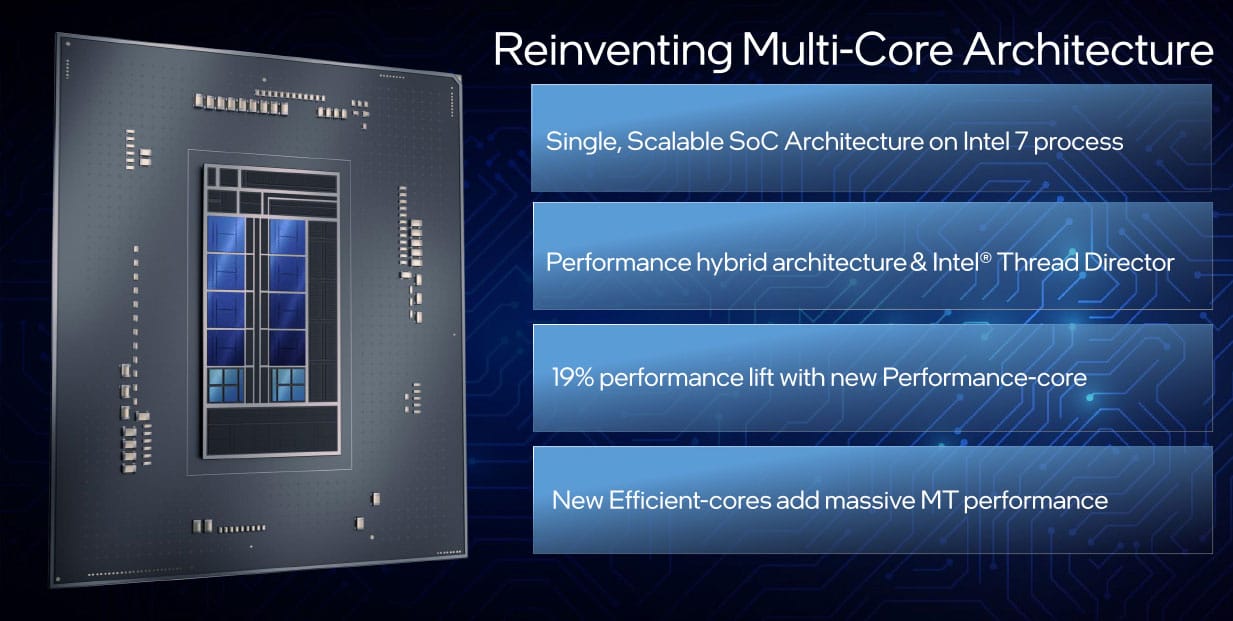
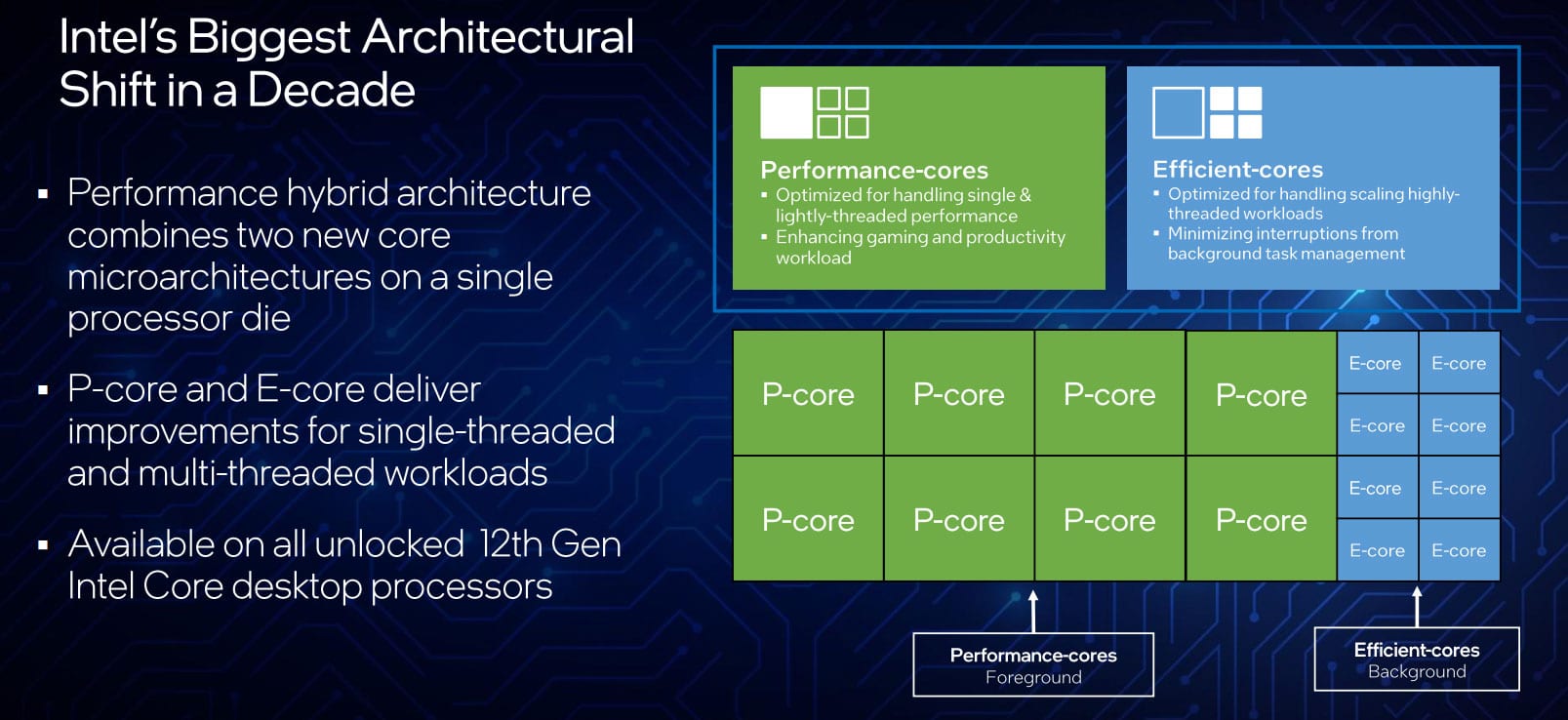

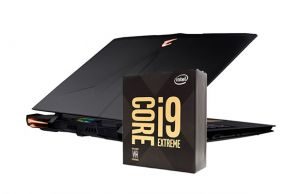
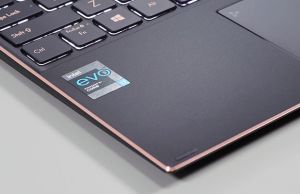
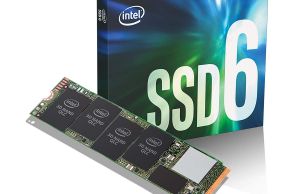
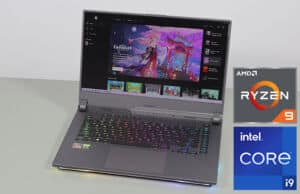
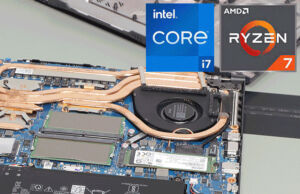
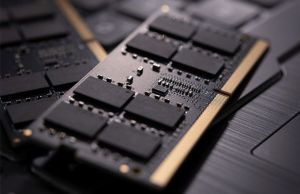




Aurelio
December 3, 2021 at 3:26 pm
Very thoughtful article, I really enjoyed. It certainly touches on many aspects that I had yet to think about.
I agree with you wholeheartedly; besides that, Windows 11 is about one year away (at least) from true stability, and those machines probably won't work as well as they could on windows 10 (if we force a clean installation).
I still can't quite make sense of how these Intel Iris iGPUs with 96 EUs would compare to the current AMD Vega 8 (or even the next Navi 2 on Rembrandt chips). I guess we'll probably only see the light on this topic after January.
By the way, in the end, where it reads "a refinement of their previous Zen2 Ryzen 5000" it should probably be Zen3, instead of Zen2, maybe? (except for Lucienne, I think)
Apparently, there has been also another i7 Alder Lake leak (12800H) that isn't contemplated in your article yet:
wccftech.com/intel-core-i7-12800h-alder-lake-p-cpu-benchmarks-leak-out-too-up-to-25-faster-than-amd-ryzen-7-5800h-cpu-in-single-threaded-test/
Once again many thanks for your hard work.
Cheers,
Aurelio.
Andrei Girbea
December 3, 2021 at 3:40 pm
Hi, thanks for your feedback. As far as I understand, Windows 11 would be a requirement for Alder Lake laptops, as its scheduler would be better optimized to divert loads between the P and E Cores. So I don't think running Windows 10 would be a solution, but we'll see.
As for the iGPU parts, we can make a general idea of how the Intel Iris 96 EUs chip compares against the current Vega 8, from coverage of the Core i7-11370H processor (vs Ryzen 7/9 ). We'll see, as well as how next-gen Vega will compare.
Not sure what's what about the 12700H and 12800H. They look very similar from the few leaks available at this point.
David
December 4, 2021 at 1:22 pm
Alderlake GPUs at GT2. There's no GT3, at least according to the leaks.
Geekbench is underestimating performance in MT. Notebookcheck's exclusive tests show the 12700H outpeforming the 11980HK by 15% in ST and nearly 50% in MT in Cinebench workloads.
You'll notice Geekbench shows Amberlake performing within 10% of the 28W U in ST, yet in real world it shows 50% difference.
The 15W Alderlake 2+8 chips should outperform 25W+ Tigerlake U chips by a noticeable amount. They are getting their MT competitiveness back this generation. At similar TDP 2x in MT won't be a big surprise.
Andrei Girbea
December 8, 2021 at 12:12 pm
I wouldn't get hasty on conclusions based on these early leaks. Sure, at low W Alder Lake should be very competitive, but we'll see about the H lineups.
You're right about GT2 for most of the Adler Lake chips, though. Updating
DavidC1
December 10, 2021 at 5:32 am
There's no GT3 for Alderlake.
notebookcheck.net/New-leak-confirms-Xe-GT3-iGPU-for-some-Alder-Lake-Mobile-processors.567624.0.html
You might be mistakenly referencing the notes about Alderlake-M having "GT3". First, M is not P. Second, they still talk about maximum of 96EUs so how is it anything else other than possibly marketing?
Even NBC mistakenly thinks Alderlake-M GT3 means Alderlake Mobile GT3, while the original source(always check the original source) says Alderlake M, and P separately. Meaning for some reason they have GT3 next to the 5-9W M parts.
Considering they'll be limited entirely by power use why call it GT3 anyway?
Rumor mill says possibly we might get greater-than-GT2 by the Meteorlake generation. Until then.
-Alderlake performance: Geekbench is too synthetic and too much of a user benchmark to be of much use as a leak benchmark.
Andrei Girbea
December 10, 2021 at 11:47 am
Thanks for the update! I was actually referring to the 32EUs on the S-BGA platforms, the UHD Graphics 770, but you're right that those are not GT3, but Alder Lake GT1 if I'm hopefully not mistaken. I rarely report on rumors and these sorts of technical details, so excuse the error on my part and lack of proper documentation before replying.
As per Geekbench, I agree as well, but it's the least we get for now. Also, keep in mind that those results are on early pre-production units with early software. Based on the few Alder Lake preview units that I have over here, the results can vary greatly between implementations of the same chip. I'm not running the free Geekbench tests though so my results won't appear in the leaks :P
Phil
December 6, 2021 at 2:33 pm
I just wish Intel released some of these Alder Lake mobile chips into the desktop segment with much bigger power envelopes. The desktop space is crying out for a 96eu iGPU right now and with a 125w (241w) TDP it would be a killer chips.
Fred32
December 11, 2021 at 1:48 am
while informative, as a professional audio engineer with intermediate knowledge of pc's and diy building it sure would be nice to know, in laymans terms, whether or not its worth it to buy now or wait.. until when? are we talking a 1st quarter release, 2nd? .. if 13th gen is also scheduled to be released in 2022, I mean whats the point investing a few grand into either of these 11th/12th gen already "old" models now. UGH. with intel 12th gen, pcie 5, ddr5, win 11, in terms of mb's ram storage etc., for whatever reasoning it sure feels like all of these companies (and most reviews and articles) are purposefully trying to confuse customers right now. when I last built a "super" pc in 2015, it certainly was a way more straight forward clear process than the quagmire of today. frustrating to say the least.
Andrei Girbea
December 11, 2021 at 11:15 am
I'd expect in-store availability around Feb-March, but that might vary between regions, especially with the current chip shortage and transportation problems, plus the delays in manufacturing due to the Chinese New Year.
As for the other part, there's always going to be a next best thing, a new platform, etc. My advice is to buy what works for you at the time that you need it. There are some improvements between generations, but for the most part, they are not major. 12th gen Intel should be quite a significant change over the previous platform because of the Big.Little design that's going to address both efficiency on battery and performance in demanding loads. At least that's the theory, we'll see how it actually works once we get to review units.
If you can elaborate on the "purposefully trying to confuse customers", I'd gladly help out figure things out.
Fred32
December 13, 2021 at 2:01 am
Oh yeah for sure, always something better around the corner. Just seems to me this latest tech is quite a notable advancement over recent years and the perfect time to upgrade a system that is struggling to handle the latest VST and system resource hungry programs.
Perhaps I was a bit harsh in wording, but then again while attempting to decipher the numerous Z690 naming/spec schemes, trying to figure out which MB to best pair with a 12th gen i7/i9 CPU to take full advantage of the latest (and forthcoming) technology, especially PCIe 5.0 and DDR5 implementations, has been somewhat of a frustrating task, to say the least. The wording of some reviews and manufacturers info packets Ive found to be a bit misleading.
Anyway, ultimately the point being, to wisely invest in building a somewhat future-proof workstation. If its late 1st/early 2nd quarter, I'll certainly be waiting for the next wave to drop rather than going with a 12th gen desktop and an "old" 11th gen mobile rig. Will be interesting to see how the pricing lines up.. so far pricing here hasn't budged, yet. Thanks again for the informative posts.
Alec
December 21, 2021 at 5:06 am
@Fred32 – maybe get a Macbook Pro and you can sidestep Intel and AMD completely
Nicky
January 4, 2022 at 10:41 am
I wholeheartedly agree. I'm a professional audio engineer and producer and a few months ago I made the transition and bought an M1 MacBook Pro and I've never had a smoother experience with producing, mixing, and mastering. Definitely give Apple Silicon some thought.
Eric
January 7, 2022 at 12:24 am
First, thanks for all your hard work reporting on the ultrabook market. I'm not sure why it took me this long to find and identify your site as a go-to resource for laptop research. I'm in the hunt for a new laptop as I start a new job, and your article containing a comprehensive list of the lightest laptops and ultrabooks in 2021 is exactly what I need.
My main question is in regards to a potential refresh of the LG Gram lineup. Do you think LG will be updating their LG Gram line within the first of second quarters of 2022? After recently trying the LG Gram 16 at a MicroCenter, I've kind of fallen for the machine and am leaning heavily towards getting it. However, I am wondering if LG will be releasing new models in the near future and whether they'll be worth the wait. Power/performance shouldn't be an issue for me considering my expected workload, so I've gravitated towards the LG Gram 16 for it's absurd screen size to weight ratio. I'm guessing the current model would be sufficient for me, but if there are substantial upgrades to the battery life and features like the speakers or webcam, I might be able to hold off on purchasing a current model.
For reference, other laptops I'm considering are the Thinkpad X1 Carbon, Dell XPS 13, and HP Elite Dragonfly, but those all obviously have smaller screen sizes. Thanks in advance (to you or anyone else who wants to weigh in) for any insights you can offer!
Andrei Girbea
January 7, 2022 at 11:08 am
Hi. I don't have any inside information with LG but I'd expect they'll update their Grams at some point. However, they've been slower to update in the past compared to other OEMs, so I don't think it's going to happen in Q1. Maybe in Q2?
Thus, if you're OK with the performance levels of the current-gen, just go with it as long as you can find it for a good price. No way to tell right now if they'll update other aspects besides the hardware platform